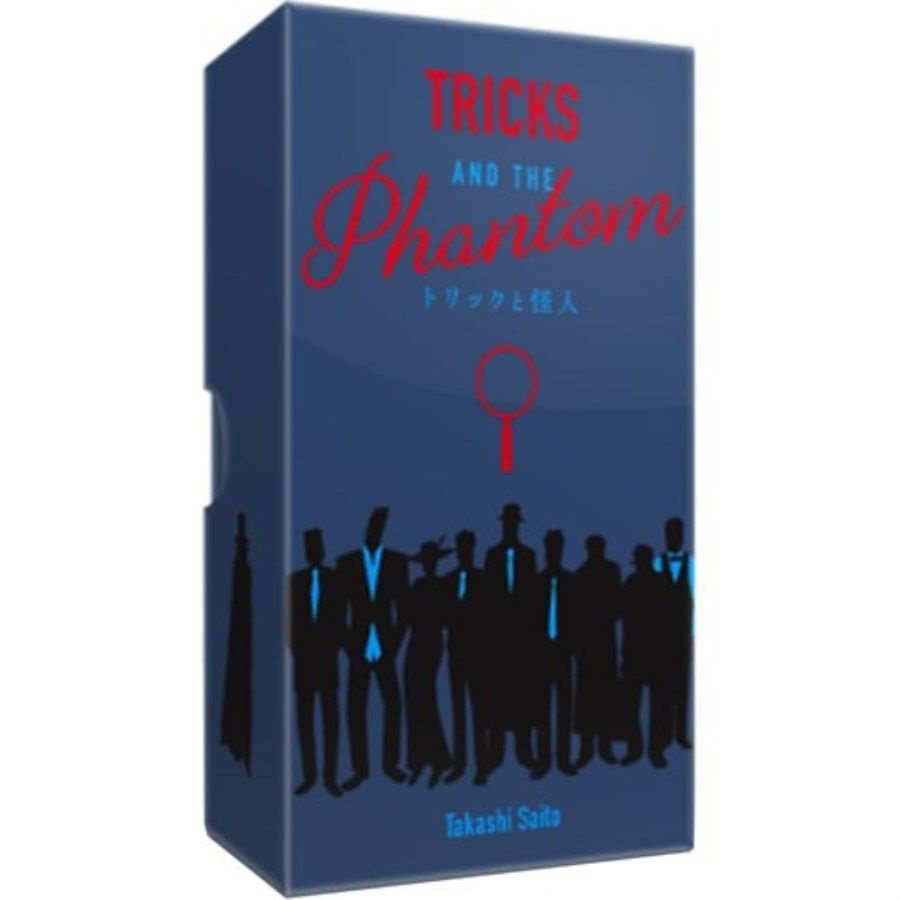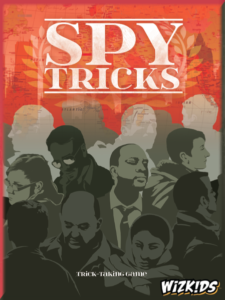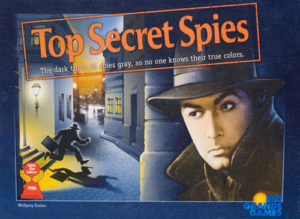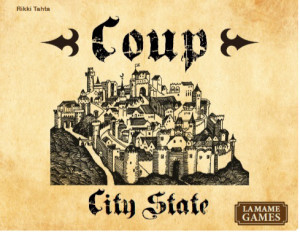- Learning time
- 10 minutes
- First play time
- 30 minutes
Tricks and the Phantom
Designed by: Takashi Saito
Tricks and the Phantom is a 2-4 player game (at its best with 4) of trying to be the criminal, guess who the criminal is, or fool everyone else into thinking you’re the criminal, when actually you’re the Phantom…
Before play starts, everyone is given three markers: the car (blue) gem (red) and bottle (yellow). Each round plays simply: players are dealt two cards each from a very small deck. There’s one of each card and they each have a role, number, and colour, from the blue Politician (10) all the way down to the lowly yellow Barkeeper (2) (The Phantom (1) is something of an exception we’ll come to shortly).
Everyone chooses a card to play (face-down) to the table, beginning with the starting player and continuing clockwise around the table. When you play a card, you must put a marker on it that matches the colour of the card played. If you place a red marker down on your card, for instance, I know you’re probably* going to be the Madame, Forensicist or Shopkeeper. Once everyone has played a card with a marker, everyone then places their guess as to who is the criminal: by default, this is the highest-numbered card. And being the criminal scores you a point, which is good. But although the lower-numbered cards have the odds stacked against them mathematically, the roles have a special power that may eliminate a higher-numbered card…
For instance, if someone played the Politician (10) but you played the Barkeeper (2), you’re the criminal. The modest Shopkeeper (4) excludes powerful Yakuza (9), the Smuggler (3) wins if all other cards are (5) or higher, and the Forensicist (5) excludes the Politician but – unlike the barkeeper – must still be a higher number than the other cards. If the Detective (6) manages to be the highest card, it scores double. Once the first turn is resolved, the second cards are played in the same way and then the cards are all shuffled and a new round begins.
*In the midst of all this are the semi-worthless Phantoms (1). There are two of them, and the Phantoms can never be the criminal, but can completely ignore the marker rule and place whatever colour marker they like on the Phantom card, allowing you to bluff you’ve a potential criminal in your possession: if you get anyone guessing your phantom, they must pay you a point. You also get a point (or points) for guessing the criminal correctly, a point for being the criminal, and the first to ten points wins the game.
The guru's verdict
-
Take That!
Take That!
Although there's no direct interaction, the game definitely has a Take That presence - you're trying to fool people with the phantom and steal from them, and may 'steal' a win with a low card from a high one.
-
Fidget Factor!
Fidget Factor!
Very low.
-
Brain Burn!
Brain Burn!
The whole game hinges on the fact your knowledge is incomplete, so the weight of working-stuff-out is more about hunches than dry optimisation - although in the second turn of any round you always have more information than the first, as several cards have been played.
-
Again Again!
Again Again!
It's reasonably accessible, reasonably breezy, and can never be predicted.













Sam says
I love the Oink games presentation style and I'm generally drawn to their curious themes and mechanics. This one didn't quite hit home for me in the way Deep Sea Adventure, Startups, Maskmen or Insider did though. I think it suffers with less than four players: the amount of missing cards goes up, and the possibilities with it; meaning the hidden-knowledge thing escalates from calculated guesswork into more random speculating. The attendant sense of if-this-then-that of how the card roles work also mean the first two or three plays have a fair bit of attendant rules-referencing; more than a ten minute game really needs. But - get into it, and which card does what will become second nature. And if you like the nature of these speedy who-is-X type games, Tricks and the Phantom is certainly a cleverly constructed one.